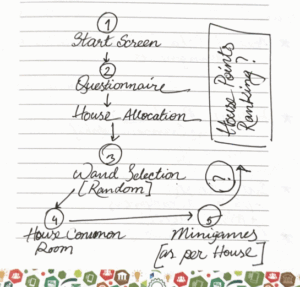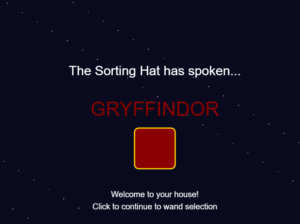Concept
For my midterm project, I’m building an interactive Hogwarts experience. The player starts by answering sorting questions that place them into one of the four houses. Then they get to choose a wand and receive visual feedback to see which wand truly belongs to them. After that, the player will enter their house’s common room and either explore various components in the room or play a minigame to earn points for their house.
The main idea is to capture the spirit and philosophy of each Hogwarts house and reflect it in the minigames, so the experience feels meaningful and immersive. Instead of just random games, each minigame will be inspired by the core traits of Gryffindor, Hufflepuff, Ravenclaw, or Slytherin.
Design
I want the project to feel smooth and interactive, with a focus on simple controls mostly through mouse clicks. Each stage (from sorting, to wand choosing, to the common room minigames) will have clear visual cues and feedback so the player always knows what to do next.
For the minigames, I’m aiming for gameplay that’s easy to pick up but still fun, and thematically tied to the house’s values. The design will mostly use basic shapes and animations in p5.js to keep things manageable and visually clean.
Challenging Aspect
The part I’m still figuring out and find the most challenging is designing minigames that really match each house’s philosophy but are also simple enough for me to implement within the project timeline. It’s tricky to balance meaningful gameplay with code complexity, especially because I already have a lot of different systems working together.
Risk Prevention
To manage this risk, I’ve been brainstorming minigames that are easy to build, like simple clicking games for Gryffindor’s bravery or Memory games for Ravenclaw, while still feeling connected to the houses’ themes. I’m focusing on minimal input and straightforward visuals so I can finish them reliably without overwhelming the code.



